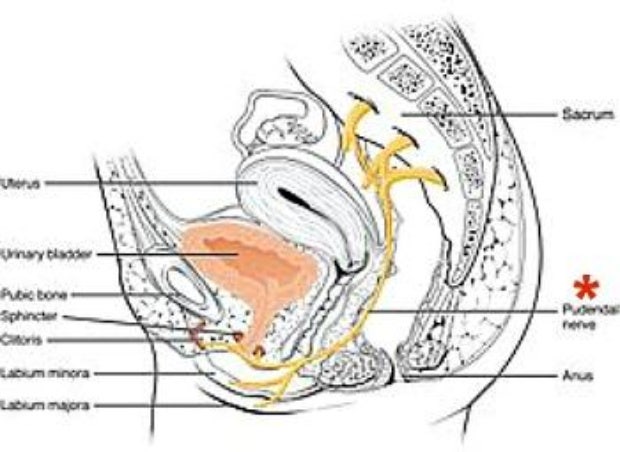Why I'm Done Being Ashamed Of Using Medical Marijuana To Treat My Chronic Pain
"If that makes me a weed mom, so be it."
 Getty Images
Getty Images Confession: I finally found medicine that helps provide relief for my chronic nerve pain — and it's medical marijuana. But, at least until right now, I’ve been too ashamed to admit using it.
I’m a product of Nancy Reagan’s “Just Say No” campaign and a child of the “War on Drugs”; therefore, I’ve always associated marijuana with engaging in high-risk behavior, and even after its legalization in many states, considered using it a big no-no.
So when I became a medical cannabis patient, I felt like I was doing something wrong, something shameful.
As it turns out, the benefits of medical marijuana have now made legal weed instrumental in managing the chronic pelvic and vaginal nerve pain I experience due to a condition called pudendal neuralgia.
What is medical marijuana?
According to the National Institute on Drug Abuse:
"The term medical marijuana refers to using the whole, unprocessed marijuana plant or its basic extracts to treat symptoms of illness and other conditions. The U.S. Food and Drug Administration (FDA) has not recognized or approved the marijuana plant as medicine.
"However, scientific study of the chemicals in marijuana, called cannabinoids, has led to two FDA-approved medications that contain cannabinoid chemicals in pill form. Continued research may lead to more medications."
Despite the fact that "the Devil's Lettuce" has been effective in treating my pain, I haven't wanted to be associated with the labels “stoner” or “pothead”, à la Cheech and Chong.
I'm also a parent, and I don’t want to be known as a “weed mom”. No judgment on the self-proclaimed "weed moms" out there. The label simply doesn't fit me.
I cringe at weed strains with names such as “Purple Urkle” and “Donkey Butter", are these are terrible names for medicine, but that's exactly what medical cannabis is — medicine.
To compound my shame, I also feel guilty for not going public to shout-down the stigma surrounding medical marijuana. The truth is, I fear the backlash that may result if I do.
Each time I visit the dispensary, anxiety nips away at my mind, giving way to an onslaught of catastrophic thoughts.
What if somebody I know sees my car parked underneath the green dispensary cross? What will they think of me? Or worse, what will they say about me to the other parents? Will they prohibit their children from playing with mine?
Because of this, I wear a hat, scarf, and sunglasses — essentially a disguise — and I remove my kid’s school decal from the car.
Naturally, I want to protect my family from everything that is, or could be, potentially dangerous, including drugs and the whispers of other parents.
I grew up with the popular anti-drug PSA, “Parents who use drugs have children who use drugs" and using it myself, even legally and for legitimate medicinal purposes, feels like an unfair burden to place upon my kids.
What’s more, I haven’t been entirely honest with friends and family about my medical condition to begin with.
Despite its prevalence among women in my age group, I've kept both my pelvic floor pain and my use of medical cannabis to manage it a secret.
According to Stephanie Prendergast, co-founder of the Pelvic Health and Rehabilitation Center (PHRC) and co-author of Pelvic Pain Explained, twenty percent of premenopausal women suffer from some kind of pelvic pain condition.
That’s not a small number, but I’m still apprehensive about sharing my experience. I mean, who wants to hear about the pain between my legs?
When the pain is written across my face or I need to cancel an engagement because of it, I use “leg pain" as my excuse. That's really a half-truth because I do also suffer from chronic leg pain, but it’s not the whole story.
Pelvic pain is nothing like leg pain.
Prendergast defines the pelvic floor as “a group of muscles that run from the pubic bone, back to the tailbone.” This network of muscle tissues is responsible for supporting internal organs such as the bladder, uterus, and rectum.
Pelvic floor pain, she says, is different from other kinds of pain because of the pudendal nerve, which innervates “most of the pelvic floor muscles, all of the pelvic genitalia, part of the urethra, part of the rectum, and part of the vagina.”

image courtesy of wikipedia
It’s the only nerve in our body that, in addition to sensation and muscle control, has “an autonomic component,” meaning that the nerve supports our organs without us having to think about it. So, the pelvic floor never fully relaxes. If it did, we would leak urine or stool.
For some people, like myself, medical cannabis is helpful for relieving pain related to the pelvic floor because it can help relax the muscle tissues and calm nerve pain.
It’s a difficult condition to diagnose because pelvic floor pain can feel like a urinary tract infection (UTI) or a yeast infection, and not like a muscle problem at all. This leads to pelvic floor conditions often being misdiagnosed as urological or gynecological issues.
For example, actress Zosia Mamet waited six long years for the correct diagnosis for her pelvic pain.
Doctors initially thought she was getting UTIs, and when her tests came back negative, she was told it was a psychological issue. Eventually, she was diagnosed with pelvic floor dysfunction and was able to find relief.
For me, the pain is best described as a "vaginal migraine" accompanied by searing, sharp pangs — not dissimilar to those of a torn ligament — and intense muscle spasms along my inner labia and at the entrance to my vagina.
I’m unable to sit for long periods of time, which makes working in an office setting impossible and traveling long distances painful. When I do sit, I need a special cushion, and I don’t take it with me everywhere because I don’t want to call attention to myself.
Let’s be honest, a seemingly healthy person using a prop like a seat cushion stirs the imagination.
Speaking of imagination, sex is awkward, infrequent, and requires both creativity and patience, but thankfully, it is possible.
Once it was suggested by my doctor, it took me a while to warm up to the idea of using medical cannabis to treat my pain.
Prior to doing so, I explored all of the standard treatments options. I was advised by my doctors to try the common medicines used for treatment of pelvic floor pain, including Uribel, lidocaine, a tricyclic antidepressant, a neuromodulator drug, and benzodiazepines.
I declined opioids and the Uribel was ineffective because it’s used to treat UTIs and interstitial cystitis, and I had neither. The lidocaine was ineffective and the antidepressant impaired my vision and caused a rapid heartbeat, which left me with crippling anxiety until it wore off.
The neuromodulator, Gabapentin, would have taken months to work. And after researching the potential side effects, which included dizziness, difficulty speaking, and memory loss, I chose not to try it.
The Clonazepam (a type of benzodiazepine) was effective for dulling the whips of pain caused by the intense muscle spasms, but it made me drowsy, constipated (which is a nightmare for people with pelvic pain), and worst of all, I noticed short-term memory problems.
The Valium, which is compounded into a vaginal suppository (yes, vaginal Valium), seemed promising because it helped to manage my symptoms without the side effects of the Clonazepam, but it caused yeast infections — which actually made me miss constipation and short term memory loss.
Only when I was out of options did I investigate the possibility of using medical cannabis.
The main selling point, for me, was the low side effect profile.
While medical cannabis is helpful, at the core of my treatment is pelvic floor physical therapy.
Pelvic floor PT involves manual manipulation of the vaginal muscle tissues and the surrounding areas, such as the glutes, legs, and hips. Deep breathing exercises are also part of the PT regime because the pelvic floor expands and contracts with the breath.
Meditation and cognitive behavioral therapy techniques can also be helpful.
The emotional and physical demands of motherhood are intensified by having chronic health problems, and these therapies, practices, and the use of cannabis allow me to participate in most daily activities with my family.
For that, I am incredibly grateful.
Dr. Anand Dugar, a board-certified anesthesiologist and pain medicine physician, views medical marijuana as a good alternative for patients taking prescription medications, particularly those with potentially life-threatening side effects and high potential for addiction, such as opioids and benzodiazepines.
“What we were doing in pain medicine, even though it was the standard of care, I didn’t think that it was the best care,” says Dugar, whose network of clinics, Green Health Docs, aims to help patients come off of, or use less of, their prescription medications.
Another benefit of medical marijuana for sufferers of chronic pain is that it often provides almost immediate relief.
Prendergast says that you don’t have to “get on and off of it” as you do with neuromodulators such as Lyrica or Gabapentin, as well as with tricyclic antidepressants.
“Typically," she says, "people will feel relief in a quicker period of time, if not immediately, where some of these drugs take a little bit longer to kick into play,” — up to six months in some cases. That’s a long time to wait if you’re in pain.
Dugar agrees that the low side effect profile of medical marijuana makes it an attractive alternative for patients who want to wean off of or limit their use of prescription medication.
He does caution, however, that medical cannabis isn’t completely benign because there is some potential for addiction — estimated to be around nine percent.
However, Dugar argues that if patients become dependent on medical cannabis or need it every day, it’s better than becoming addicted to benzodiazepines or opioids because, as he explains, “it’s better to be addicted to marijuana than it is to be addicted to pills that are going to damage your liver, other body parts, and have a much worse addiction potential.”
I never thought that I would become a medical cannabis patient. Ever.
Perhaps I would have considered it sooner if it was something that could be prescribed and picked up at a pharmacy — a place where nobody would bat an eyelash at my presence.
But even though I still get anxious visiting the dispensary, one thing being a parent has taught me is that I cannot worry about or control everything. So I’m letting this go — the War on Drugs of my youth be damned!
I’m not a pothead. I’m not a stoner. I’m a mom doing my best to manage chronic pelvic pain and trying to improve the quality of my life so that I can live it to the fullest with the people that I love.
If that makes me a weed mom, so be it. Everything else can go up in smoke — my shame included.
The author is a mother, birder, and science writer. When she’s not writing about birds, she’s writing about pelvic floor health. Drawing from her 15 years of experience with pelvic floor pain and dysfunction, her goal is to inform, educate, and encourage those who suffer to seek help from well-trained medical professionals.

